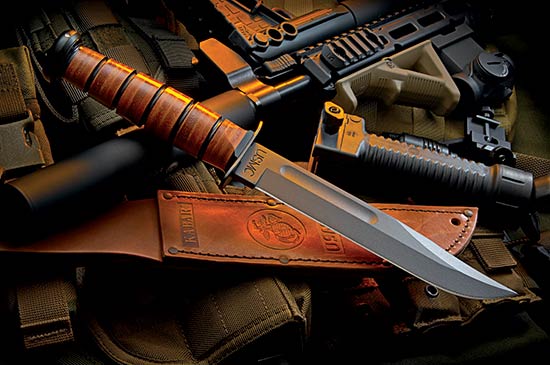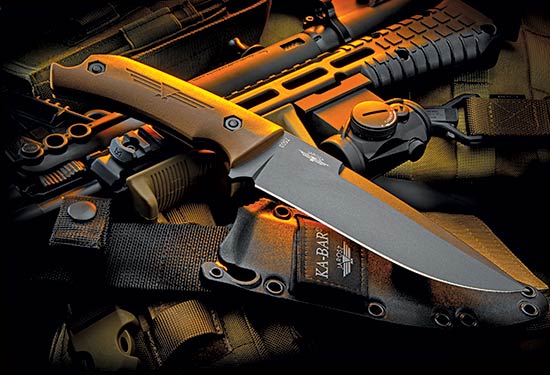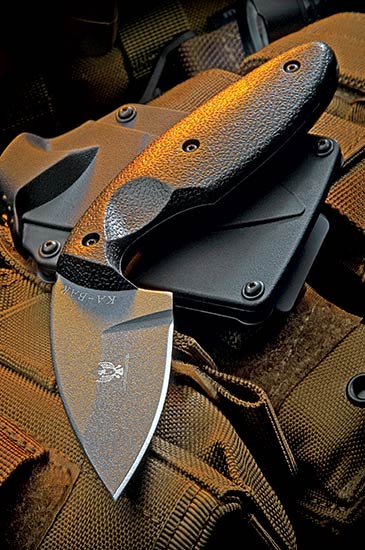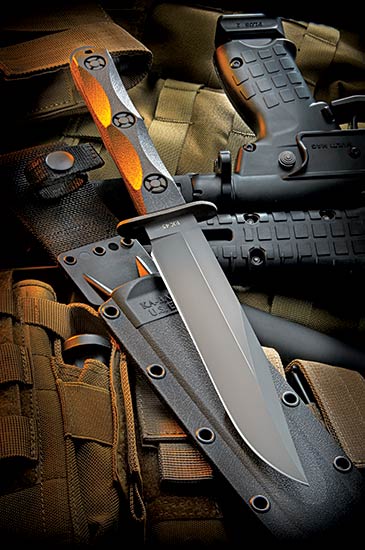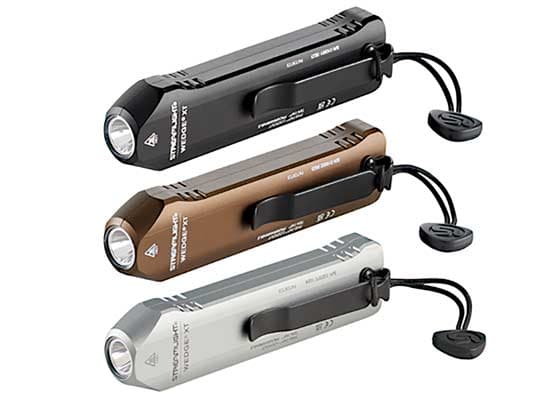The cutlery world is strewn with century-old company names existing only as figments of re-branding. KA-BAR is one of only a few who have truly stood the test of time — and done it without losing their identity and reputation for making one of the most famous fighting knives in history. KA-BAR’s soul of steel may be rooted in the past, but it also propels them into the future with sharp, fresh additions to their line-up.
“KA-BAR was founded out of the remnants of a few other small cutlery companies in the 1890’s by Wallace and Emerson Brown, and their father John W. Brown,” Marketing Manager Joe Bradley tells Handgunner. “Wallace and Emerson previously had a company called Brown Brothers Razor, as well as a knife sales firm called Union Razor. They had a warehouse in Little Valley, New York, where they essentially charged knife companies rent to store their products. When one company, Tidioute Cutlery Company, was no longer solvent the Browns took control of the assets and began to make knives. This process began in 1898.”
The Tidiuote Cutlery brand was formally changed to the Union Cutlery label in 1915, though the Union Cutlery name was used much earlier. KA-BAR Knives grew out of the Union Cutlery trademark in the mid-1920’s, but it became particularly well known — indeed famous — for the introduction of a fighting knife in the latter part of World War II. The USMC Fighting/Utility Knife remains today as the single knife most often associated with the company’s name, but the cutlery manufacturer has a much more diverse product line today. The company’s headquarters is located in Olean, New York, which has been KA-BAR’s base of operations and manufacturing since 1911.
Soul Of Steel!
Ka-Bar Enjoys A Well-Grounded
History And An Edge On The Future
History Is Still Hot!
KA-BAR’s storied history is still a big part of their current offerings, spurred on by a base of veterans, collectors and modern day users. “KA-BAR is highly regarded for the knives made famous by the US Marine Corps during World War II,” Bradley notes. “Our most popular model remains the KA-BAR USMC Fighting/Utility Knife,” he continued. But if you thought this was all there was to the company line you’re in for a real surprise — and a big treat.
“We also make knives for law enforcement, hunters, campers, Bushcrafters and anyone who wants a product they will only have to buy once,” states Joe. “Our customers are a wide-ranging, diverse group. Many like KA-BAR for the history and proven performance. We find our users range from military, law enforcement, campers, construction workers, farmers and those who simply like to keep a reliable tool by their side. The KA-BAR Becker Knife & Tool line is also immensely popular as well as the newer KA-BAR Jarosz line. Folks like that these products are American-made and have the reassurance of a lifetime warranty.”
To keep things fresh and on the leading edge of modern cutlery design, KA-BAR collaborates with some of the best knifemakers in the outdoor industry. “There are several outstanding designers we work with,” says Joe. “Ethan Becker of Becker Knife & Tool is a legendary figure in the outdoor world. Jesse Jarosz is an outstanding young designer with a wealth of knowledge. Bob Dozier is a knife icon with decades of designs. Steve Johnson of Johnson Adventure Blades has a strong presence in the hunting world, and Mike Snody of Snody Knives brings high-end materials to the lineup.”
KA-BAR has enjoyed a reputation for making tough, durable knives for decades. It’s the soul of who they are, and much of it has to do with using materials that will last a lifetime. “The blade steel we are most known for is 1095 Cro-Van,” Bradley informs. “It offers the right amount of ruggedness with ease of maintenance and reliability. It is easy to sharpen and not so hard it runs the risk of snapping under extreme stress. We also use S35VN and D2 steel on some models. For handle material we are known for our stacked leather washers on our historic knives but you’ll find a wide array of synthetic materials on our modern designs.”
Variety In Slice
A look at KA-BAR’s product line tells the tale of how the company has managed to span many decades of continuous manufacturing. The featured knives are just a glimpse, but you’ll get the idea! The legendary KA-BAR USMC Fighting/Utility Knife has received improvements over the years but you’d be hard-pressed to identify them — the company has stayed true to its original appearance and dimensions. The knife’s 7″ clip-point blade, stacked-leather handle and beefy round butt cap give the USMC Fighting/Utility Knife its original identity. Highly popular during the Vietnam War era, our troops still use it today and it’s every bit as worthy for hunting and camping field chores as ever. The leather sheath with its retention strap atop is true to the original as well.
The Ek Commando Knife is also a legendary fighting knife produced exclusively by KA-BAR, which acquired the rights to knifemaker John Ek’s designs in 2014. The Model 5 shown here is the clip-point fighter done up in 1095 Cro-Van steel with a black Parkerized finish and glass-filled nylon handle scales pinned with heavy duty X-head fasteners. Almost 13″ in overall length, the Model 5 is a brute and comes with a self-locking Celcon sheath with retaining strap and multiple tie-down points.
Ethan Becker designed and produced heavy duty camp and field knives in the late 1980’s under the Becker Knife & Tool brand and have changed very little since. They didn’t need to as these overbuilt brutes remain very popular today under the KA-BAR umbrella. The 10.6″ overall BK2 Companion (5.35″ in the blade) is a popular model among Bushcrafters and survivalists due to its wide range of capabilities, and the 1095 Cro-Van is easy to sharpen in the wilderness. The Becker line is extensive with larger blades and smaller neck knives available.
The Jesse Jarosz-designed Turok is an example of the thoroughly modern side of KA-BAR’s product line. Jarosz is a relative newcomer to the knifemaking community whose popularity has increased exponentially over the past seven years. The Turok design is a 11.5″ fixed-blade oozing with stealthy curves front to back. The 6.25″ drop-point blade has a long swedge the length of the spine for superb penetration while the deep ground edge makes for excellent slice. A Celcon synthetic sheath handles the carry chores.
Last but not least of our featured knives is the TDI Law Enforcement knife designed by John Benner, founder of the Tactical Defense Institute. This is a small knife with a radical “blade forward” design meant for back-up. Dressed in all black, the 5.63″ overall TDI LE has a 2.41″ blade with Zytel handles. This wicked little bit of business comes with a spring clip-style belt sheath for rapid access.
Endurance’s The Key
The reason for KA-BAR Knives’ success over many decades lies in their ability to ensure quality manufacturing, sound design and adaptation to the times. Their soul may be rooted in the USMC Fighting/Utility Knife, but it drives the future. Joe Bradley put it best. “Our future plans are to be having this same discussion another 120 years down the road. KA-BAR has a long, storied history and we look to that as a compass to guide us in the future.” This is all you need to know!


